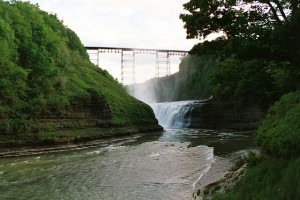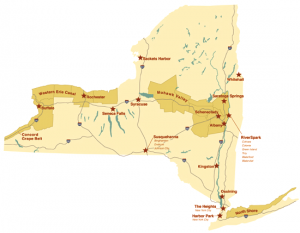By Paul M. Bray

New York State has the oldest State Park System in the USA. The System dates back to 1924 and now has 179 state parks. Many of the State Parks are first class like Niagara Falls State Park, Letchworth State Park (known as the Grand Canyon of the East), Thatcher Park near Albany and Saratoga Spa State Park and Jones Beach on Long Island, to name a few. Many are world-class natural sites while some are more known for their golf courses, campsites, swimming pools and beaches.
The State also has vast ecologically rich parks like the 6 million acre Adirondack Park with the only constitutionally protected wild forest land in the nation. The environmental parks like the Adirondack and Catskill Parks are managed by the State’s environmental agency while the more conventional state parks (some of which do have ecologically sensitive resources) are managed by the NYS Office of Parks, Recreation and Historic Preservation (ORRHP). OPRHP also has 37 historic sites and its Commissioner is the State Historic Preservation Officer.

In 1977 the State Legislature enacted a law directing OPRHP to do a plan for a statewide system of urban cultural parks (UCP) and another law designating the whole area of the 6 historic neighboring communities at the confluence of the Hudson and Mohawk Rivers as the Hudson Mohawk Urban Cultural Park. The UCP name was dropped in the 1990s when regional areas were added to the program and replaced by calling the parks “heritage areas.”
The then OPRHP Deputy Commissioner for Historic Preservation told a group of state legislators that the proposed UCPs represented the ideal for historic preservation. But concluded that “there is no way” the agency could implement a UCP law. The state legislature, however, saw it as a beneficial partnership that integrated program for conservation, education, recreation and sustainable development and by enacting a law directed the program to move forward. Commissioner of OPRHP, Orin Lehman hired the planning firm of Lane and Frenchman who had at worked on the plan for the Lowell National Historical Park to prepare a statewide plan to implement the UCPs.
Communities that wanted to be UCPs had to prepare feasibility studies to be considered for designation. By 1982 thirteen communities from New York City to Sackets Harbor on Lake Ontario were selected for designation as part of the legislation establishing the UCP system.
In 1981, Commissioner Lehman sent the legislature a letter saying, “I am pleased to submit to the Legislature this Plan for the New York Urban Cultural Park System. The plan recommends the creation of an innovative state program, which will help communities to make better use of resources they already have. These resources often lie within declining historic buildings and districts in the heart of our cities. Through the framework of the Urban Cultural Park System, these areas can serve to interpret the heritage of New York State, while becoming regional centers for economic and cultural development through a well-defined and realistic revitalization process.” He also noted that the plan for the development of New York State’s Urban Cultural Park Program received the American Planning Association’s 1981 national “Outstanding Planning Program Award.”
The State Heritage program grew to have 20 state heritage areas and the first 13 state heritage areas benefited from an environmental bond act with $20 million for visitor centers. A mix of state agency programs also helped the state heritage areas support planning and projects.
In September 1991 the National Park Service, the New York Parks, Recreation and Historic Preservation Commission and the National Parks and Conservation Association held a Partnerships in Parks & Preservation Conference in Albany. New York’s urban cultural park/heritage areas were recognized as “partnership parks.”
Mario Cuomo, New York’s Governor and father of Andrew Cuomo who is New York’s current Governor said in his introductory speech that, “The New York Urban Cultural Parks Program has used the partnership of State and local governments and the private sector to preserve some of New York’s most important and impressive downtowns. The State provides technical assistance, grant money, and marketing. The local community provides interpretive staff, capital improvements, and sponsors special events and street festivals. And the private-sector puts the buildings to work as shops, offices, museums and cultural centers.” He went on to say, “We fulfill our own needs for the growth and development of the community, and at the same time fulfill our responsibility to preserve a crucial link between past, present and future generations.”
Cutbacks in Federal program support and state recessions over resent decades ultimately led to a billion dollar backlog in maintenance needs for the traditional state parks. Budgetary issues set the stage for the undoing of the New York heritage areas. Under the administration of Governor Paterson, the small heritage area program was zeroed out although the state provided $100,000 million a year to address the maintenance issues for the traditional state parks.
To this day the State Heritage Area Law remains on the books and OPRHP has reviewed and approved a couple of additional State Heritage Area management plans as it is required to do under State Law. However, no state parks staff or funding has gone directly to State Heritage Areas.
Two years ago when current Governor Andrew Cuomo sponsored a conference on heritage tourism, representatives from the National Trust for Historic Preservation led the program and said New York State is fortunate to have a State Heritage Program. At the OPRHP table outside the meeting room, when asked for information on the State Heritage Areas, a representative said “we don’t do that program any more”. Technically by law that was not true, but in effect that is how the State Parks Agency has acted and the new era of parks in NYS, state heritage areas, has been abandoned by the very agency that created the award winning plan for state heritage areas.
What is happening in NYS is contrary to an enduring heritage of parks like Olmsted’s Central Park and Prospect Park in New York City, great traditional state parks and urban parks that the State’s highest court, the Court of Appeals, has protected through the public trust doctrine. It is very regrettable that the highest stewards of NYS parks, the Governor (the son of the former Governor who oversaw the creation of heritage areas) and the State Parks Commissioner, may have found a way to stifle State Heritage Areas that embody the great heritage of their State.
Paul Bray’s email is secsunday at aol.com
Addendum: The financial woes of the New York State Heritage Area program are not unique. The Pennsylvania Heritage Parks (renamed heritage areas) program that drew its inspiration from the New York Urban Cultural Parks also faces hard budgetary times. A direct appropriation for the program was zeroed out in the Governor’s 2009 budget and it has survived on a mixture of legislative largesse and state agency accommodation ever since. Recently elected Governor Wolf has again proposed to eliminate funding for the program. And the campaign to restore funding is in full swing. See an editorial in the commonwealth’s Lackawanna Valley paper calling to Fully Fund Heritage Areas.
Finally, there is the ongoing saga of funding for the National Heritage Area program with its 49 National Heritage Areas, which has been a tug of war between the Department of Interior’s budget recommendation to cut funding for the program in half and Congress’s druthers, which is to put the money back. So far Congress has had the last word, but it takes up a lot of time and effort that could be spent conserving our nation’s heritage.
Brenda Barrett
Editor, Living Landscape Observer



2 Responses
I understand the story, which repeats itself throughout this country, but I was hoping to get the answer to “why?” Still don’t know why?
The editor of the Living Landscape Observer has some thoughts on this topic and recognizes that it is very important. Perhaps if we can identify the “why” it will help us get the “what’ to do about it. I am interested in hearing from other large landscape initiatives on how they have sustained operational funding for work on regional efforts over time. Or if they have run into financial problems what are the root causes?
Do drop me a line and I commit to write more on this issue.